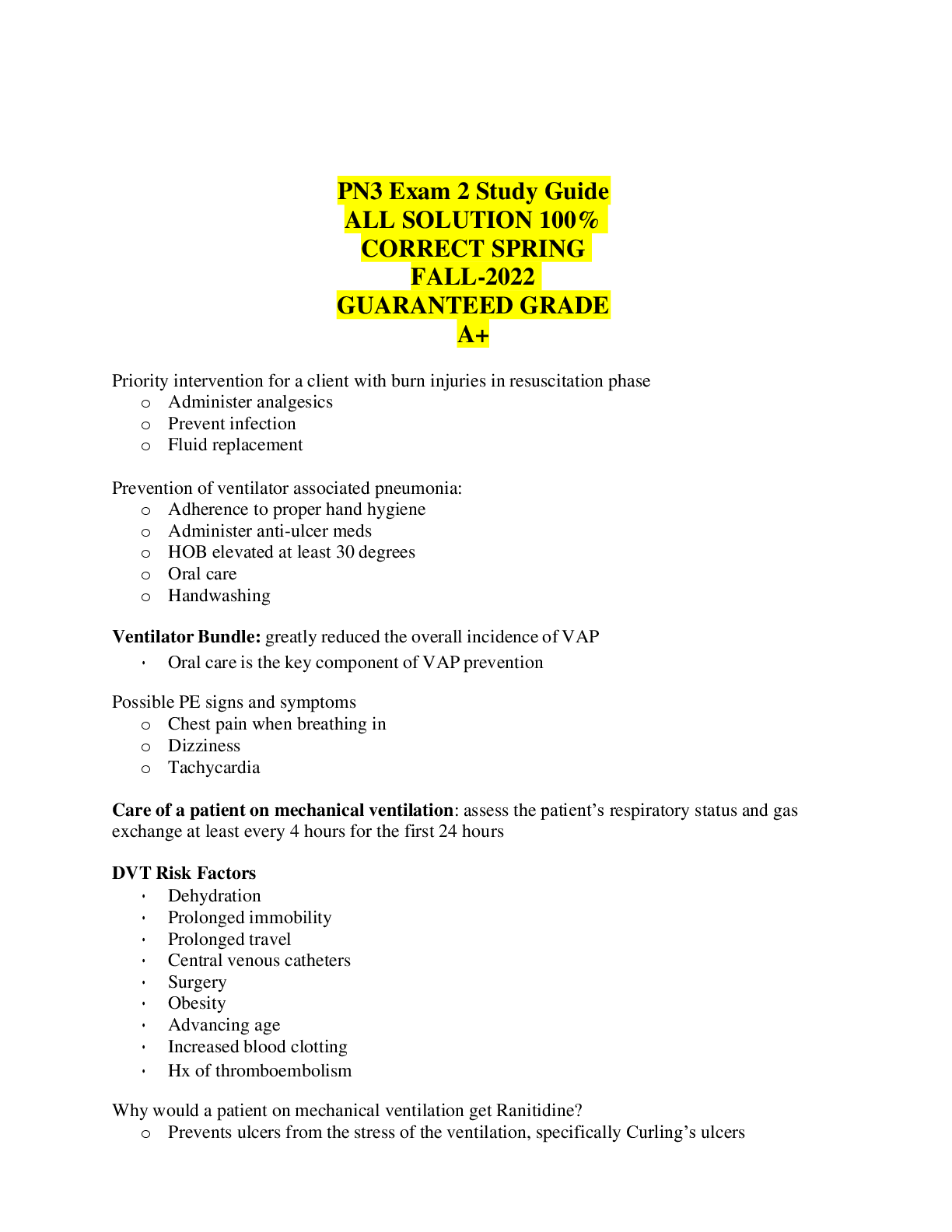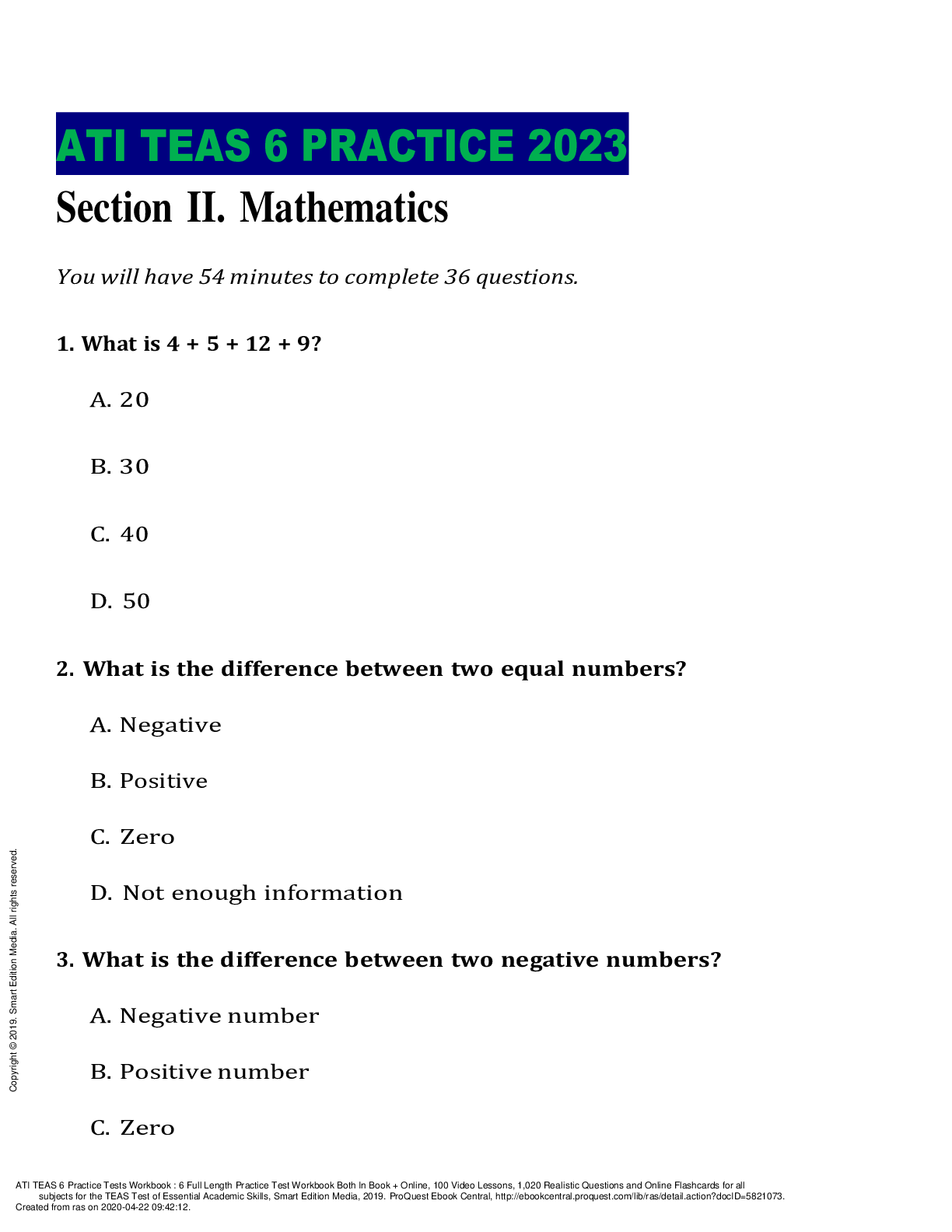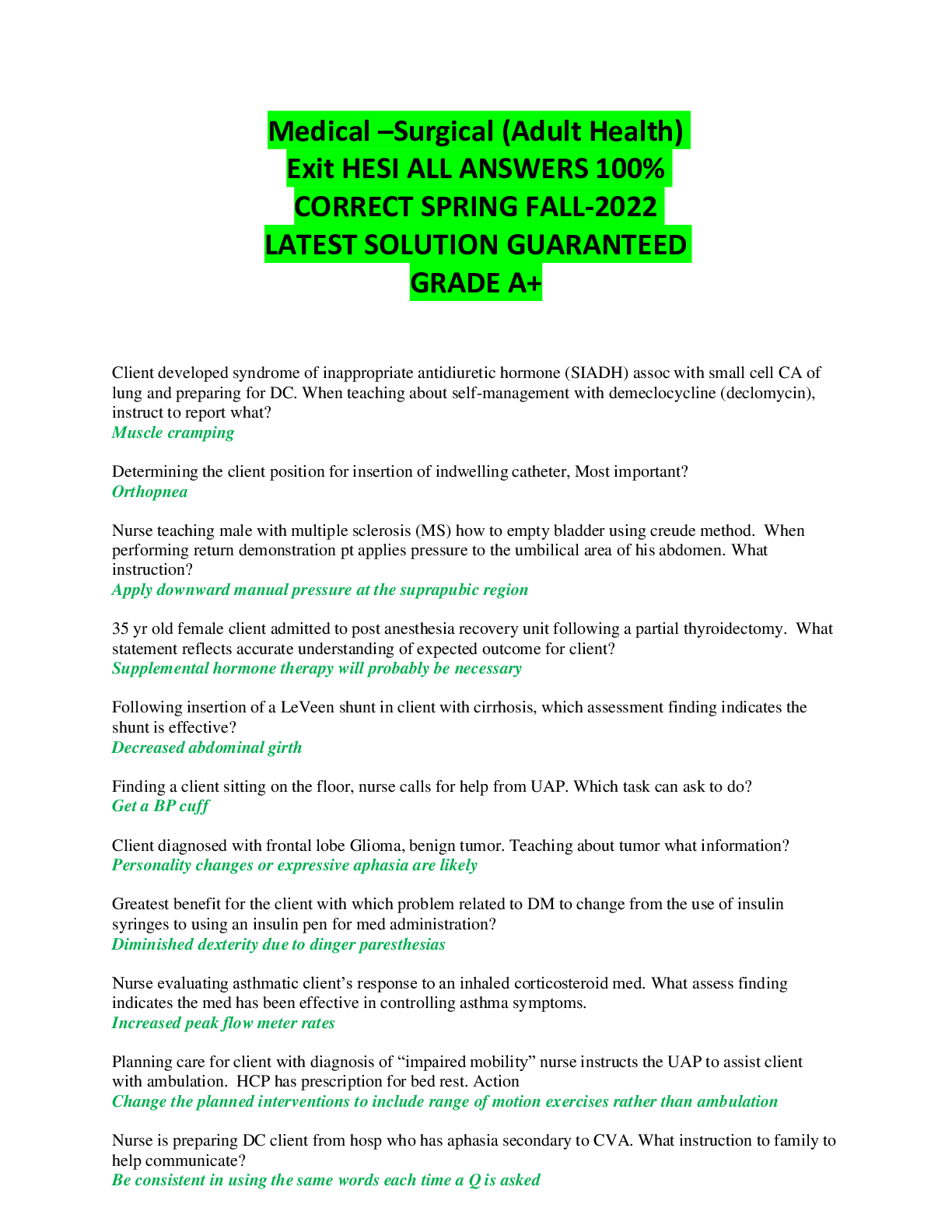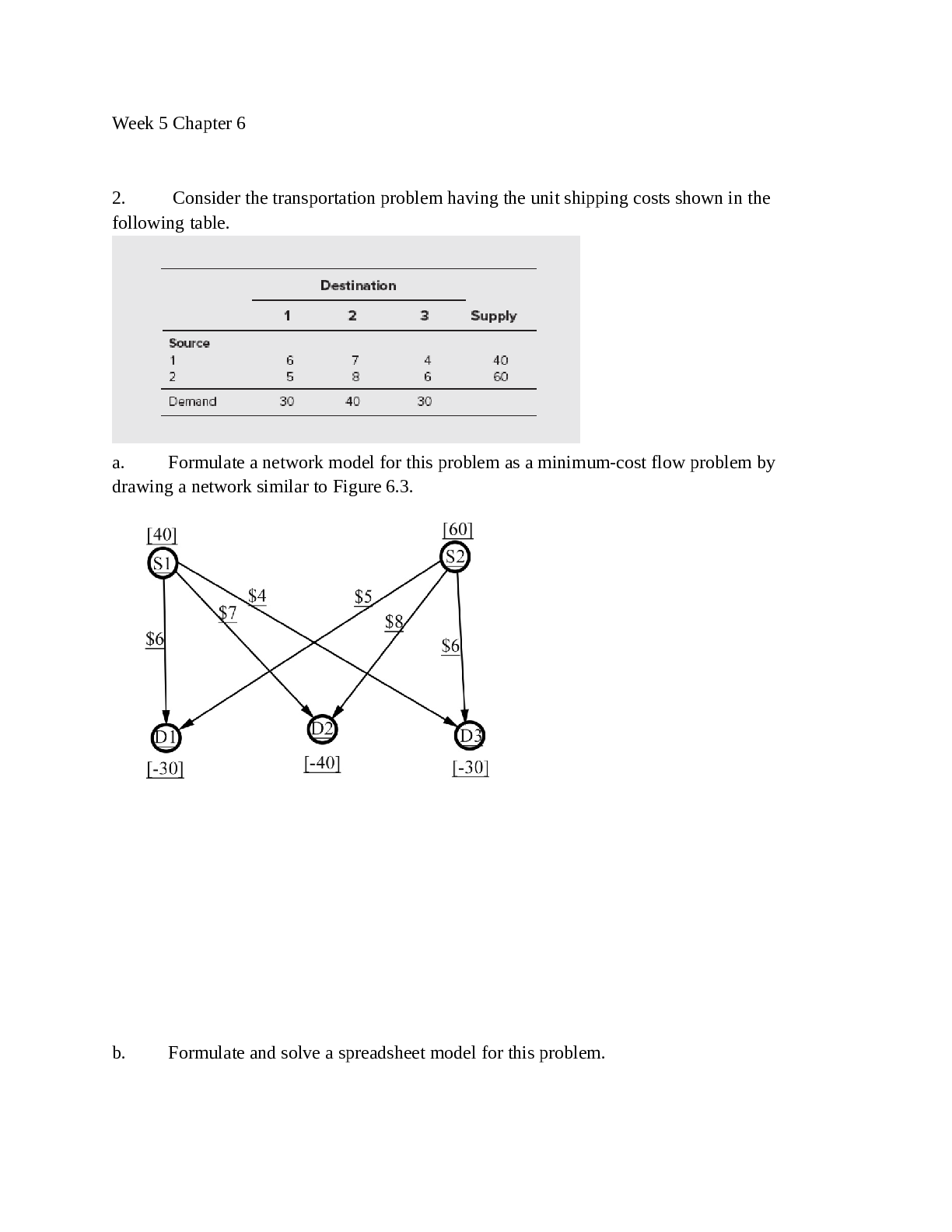*NURSING > STUDY GUIDE > PHARM STUDY GUIDE QUIZ 1- ALL ANSWERS 100% CORRECT SPRING FALL-2022 LATEST SOLUTION GUARANTEED GRADE (All)
PHARM STUDY GUIDE QUIZ 1- ALL ANSWERS 100% CORRECT SPRING FALL-2022 LATEST SOLUTION GUARANTEED GRADE A+
Document Content and Description Below
MODULE 1 1. What are the BON rules and regulations for prescriptive authority for the advance practice nurse? 1. Texas is very restricted 2. Describe the pharmacokinetic processes of absorption, di... stribution, metabolism and elimination and how differences in these areas affect drug action. 1. Absorption 1. Drug’s movement from the site of administration into the blood. 2. Distribution 1. Drug’s movement from the blood into the interstitial space of tissues and from there into cells. 3. Metabolism 1. Biotransformation is the enzymatically mediated alteration of drug structure. 4. Elimination 1. Combination of metabolism and excretion 3. Compare and contrast pharmacokinetics and pharmacodynamics of special populations—pediatrics, older adults and those that are pregnant. 1. Pediatrics—they have organ immaturity, elderly—they have organ degeneration, loss of nephrons, excretion of drug is decreased and you have to give this population a lower dose of medication. Medication can pass through milk of lactating females. 4. Analyze a drug interaction to determine an appropriate course of action. 1. Basic mechanism of drug-drug interactions through pharmacokinetic interactions are altered absorption, altered distribution, altered metabolism, and altered renal excretion. 5. Identify medications with a narrow therapeutic index requiring drug level monitoring. 1. 6. Discuss the effect of ionization and pH on absorption. 1. Drugs that are weak acids are best absorbed in acidic environments. Acidic drugs accumulate on the alkaline side, basic drugs accumulate on the acidic side known as ion trapping. Ionization of the drugs is pH dependent, when the pH and the fluid on one side of the membrane differs from the pH on the other side, drug molecules tend to accumulate on the side where the pH most favors ionization. 7. Discuss factors affecting drug distribution. 1. Competition for protein binding and alteration of extracellular pH 8. Discuss barriers affecting drug distribution—such as placental membrane, blood brain barrier and volume of distribution. 1. Placental membrane: drugs are easily passed through the placental membrance 2. Blood brain barrier: the PGP pumps drugs back into the blood and thereby limits their access to the brain. 3. Volume of distribution: 9. Discuss the “first-pass effect”—what effect can this have on distribution of a drug? 1. Rapid hepatic inactivation of certain oral drugs. When drugs are absorbed by the GI tract, they are carried directly to the liver through the hepatic portal vein before entering the systemic circulation. If the capacity of the liver to metabolize the drug is extremely high, this drug can be completely inactivated on its first pass through the liver. 10. Discuss the significance of the Cytochrome P450 system on metabolism of drugs. 1. It is a group of 12 closely related enzyme families. CYP1, CYP2, CYP3 metabolize drugs. The other 9 families metabolize endogenous compounds (ex. Fatty acids, steroids). 11. Discuss the major hepatotoxic drugs and possible effects on drug metabolism. 1. 12. List various routes of drug elimination—review normal renal function including glomerular filtration, passive tubular reabsorption and active tubular secretion; describe the implications on drug clearance and how elimination affects prescribing. 1. 13. Discuss terms used to describe drug actions-agonist, partial agonist, antagonist. 1. Agonist: molecules that activate receptors 2. Partial agonist: Only has moderate intrinsic activity. Maximal effect that a partial agonist can produce is lower than that of a full agonist. 3. Antagonist: Produce their effects by preventing receptor activation by endogenous regulatory molecules and drugs. 14. Discuss the impact of food on drug absorption, drug metabolism and on drug toxicity and action—as well as the timing of drug administration. LIFESPAN 1. Hepatic metabolism and GFR increase during pregnancy, dosages of some drugs may need to be increased. 2. Rate of albumin to water decreases 1. Third trimester: Renal blood flow is doubled and renal excretion is accelerated (drugs excreted rapidly) 2. Tone and mobility of bowel decrease 3. Prolongation of drug effects Total (½ life increases) 3. Understand stages of development in pregnancy 1. Conception: through week 2 2. Embryonic period: week 3-week 8 a) Gross malformations can be produced by teratogens 3. Fetal period: week 9-delivery 4. Understand pregnancy labeling 1. 3 categories now a) Pregnancy, lactation, male & female reproductive potential 5. How do you decrease risk in the infant during breastfeeding? 1. Take meds immediately after breastfeeding, avoid drugs that have long half-lives, choose drugs that tend to be excluded from milk, avoid drugs that are known to be hazardous. 6. How do pediatric patients differ in their response to medications? 1. Absorption a) Oral? 1. Neonates: drug remain in the stomach longer which increases the levels, low acidity can affect the absorption of acid labile drugs b) Parenteral? 1. Reponses are slow and erratic. 2. Infancy: absorption is more rapid than in neonates & adults 3. Best avoided in infants c) Transdermal? 1. Greater skin permeability which increases topical drug absorption and increases the risk for toxicity 2. Distribution a) Protein binding 1. Neonates: less protein-binding—increased availability of highly protein bound drugs such as phenytoin, diazepam, and phenobarbital. Reduced dosages needed in these highly bound drugs. b) Blood Brain Barrier 1. Not fully developed at birth, drugs have easy access to the CNS, doses should be reduced. 3. Metabolism a) Hepatic function? 1. Liver hasn’t reached full maturation—sensitive to drugs eliminated by the CYP450. Liver’s ability to metabolize drugs increases about one month after birth. b) T half life 1. Decreased by as much as 48-72 hours 4. Excretion a) Renal? 1. GFR is significantly reduced at birth, drugs eliminated by the kidneys must be given in a reduced dosage and longer dosing intervals. 7. What education needs to be given to parents? 1. What to do if child spits out medication or throws it up 2. Effective education: dosage size and timing, route, technique of administration, duration of treatment, how to store the drug, nature and time course of the desired response, nature and time course of adverse reactions. 8. How do you convert pounds to KG? 1. Divide weight by 2.2 9. What is definition of polypharmacy? Is polypharmacy always inappropriate? What is Beer’s List? 1. Polypharmacy: 3 or more prescription drugs in conjunction-+ with 3 or more dietary supplements. 2. No 3. List that identifies drugs with a high likelihood of causing adverse effects in the elderly [Show More]
Last updated: 2 years ago
Preview 1 out of 36 pages
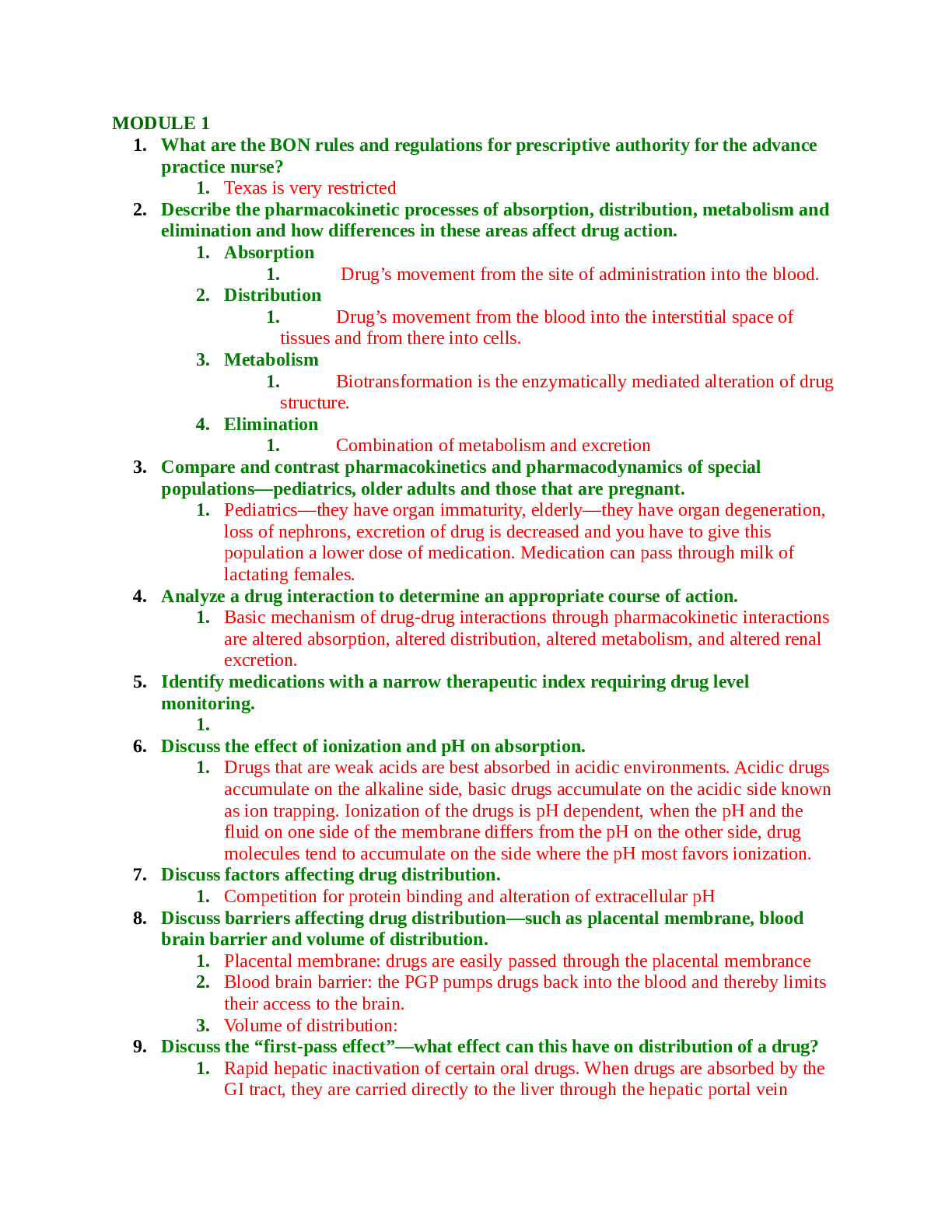
Buy this document to get the full access instantly
Instant Download Access after purchase
Buy NowInstant download
We Accept:

Reviews( 0 )
$13.50
Can't find what you want? Try our AI powered Search
Document information
Connected school, study & course
About the document
Uploaded On
Aug 19, 2022
Number of pages
36
Written in
Additional information
This document has been written for:
Uploaded
Aug 19, 2022
Downloads
0
Views
62

